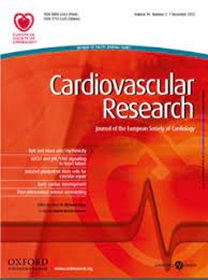Zebrafish arterial valve development occurs through direct differentiation of second heart field progenitors
IF 10.2
1区 医学
Q1 CARDIAC & CARDIOVASCULAR SYSTEMS
引用次数: 0
Abstract
Aims Bicuspid Aortic Valve (BAV) is the most common congenital heart defect, affecting at least 2% of the population. The embryonic origins of BAV remain poorly understood, with few assays for validating patient variants, limiting the identification of causative genes for BAV. In both human and mouse, the left and right leaflets of the arterial valves arise from the outflow tract cushions, with interstitial cells originating from neural crest cells and the overlying endocardium through endothelial-to-mesenchymal transition (EndoMT). In contrast, an EndoMT-independent mechanism of direct differentiation of cardiac progenitors from the second heart field (SHF) is responsible for the formation of the anterior and posterior leaflets. Defects in either of these developmental mechanisms can result in BAV. Although zebrafish have been suggested as a model for human variant testing, their naturally bicuspid arterial valve has not been considered suitable for understanding human arterial valve development. Here, we have set out to investigate to what extent the processes involved in arterial valve development are conserved in zebrafish and ultimately, whether functional testing of BAV variants could be carried out. Methods and Results Using a combination of live imaging, immunohistochemistry and Cre-mediated lineage tracing, we show that the zebrafish arterial valve primordia develop directly from SHF progenitors with no contribution from EndoMT or neural crest, in keeping with the human and mouse anterior and posterior leaflets. Moreover, once formed, these primordia share common subsequent developmental events with all three aortic valve leaflets. Conclusions Our work highlights a conserved ancestral mechanism of arterial valve leaflet formation from the SHF and identifies that development of the arterial valve is distinct from that of the atrioventricular valve in zebrafish. Crucially, this confirms the utility of zebrafish for understanding the development of specific BAV subtypes and arterial valve dysplasia, offering potential for high-throughput variant testing.斑马鱼动脉瓣膜的发育是通过第二心场祖细胞的直接分化实现的
目的 双腔主动脉瓣(BAV)是最常见的先天性心脏缺陷,至少影响 2% 的人口。人们对主动脉瓣二尖瓣的胚胎起源仍然知之甚少,很少有检测方法验证患者的变异体,这限制了对主动脉瓣二尖瓣致病基因的鉴定。在人类和小鼠中,动脉瓣膜的左右瓣叶产生于流出道垫,间质细胞来源于神经嵴细胞,上覆心内膜则通过内皮细胞向间质转化(EndoMT)形成。与此相反,第二心场(SHF)的心脏祖细胞直接分化形成前后小叶的机制不依赖于内皮细胞间充质转化(EndoMT)。上述任何一种发育机制的缺陷都可能导致 BAV。尽管斑马鱼被建议作为人类变异测试的模型,但其天然双尖瓣动脉瓣膜并不适合用于了解人类动脉瓣膜的发育。在此,我们着手研究斑马鱼的动脉瓣膜发育过程在多大程度上是保守的,并最终研究能否对 BAV 变体进行功能测试。方法与结果 结合使用活体成像、免疫组织化学和 Cre 介导的系谱追踪技术,我们发现斑马鱼的动脉瓣膜原基直接由 SHF 原基发育而成,没有内胚层间质(EndoMT)或神经嵴的贡献,这与人类和小鼠的前后瓣叶一致。此外,一旦形成,这些原基与所有三个主动脉瓣叶有着共同的后续发育事件。结论 我们的工作强调了从 SHF 开始的动脉瓣叶形成的祖先保守机制,并确定了斑马鱼动脉瓣的发育与房室瓣的发育不同。重要的是,这证实了斑马鱼在了解特定 BAV 亚型和动脉瓣膜发育不良的发展方面的实用性,为高通量变异测试提供了潜力。
本文章由计算机程序翻译,如有差异,请以英文原文为准。
求助全文
约1分钟内获得全文
求助全文
来源期刊

Cardiovascular Research
医学-心血管系统
CiteScore
21.50
自引率
3.70%
发文量
547
审稿时长
1 months
期刊介绍:
Cardiovascular Research
Journal Overview:
International journal of the European Society of Cardiology
Focuses on basic and translational research in cardiology and cardiovascular biology
Aims to enhance insight into cardiovascular disease mechanisms and innovation prospects
Submission Criteria:
Welcomes papers covering molecular, sub-cellular, cellular, organ, and organism levels
Accepts clinical proof-of-concept and translational studies
Manuscripts expected to provide significant contribution to cardiovascular biology and diseases
 求助内容:
求助内容: 应助结果提醒方式:
应助结果提醒方式:


